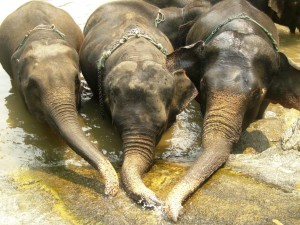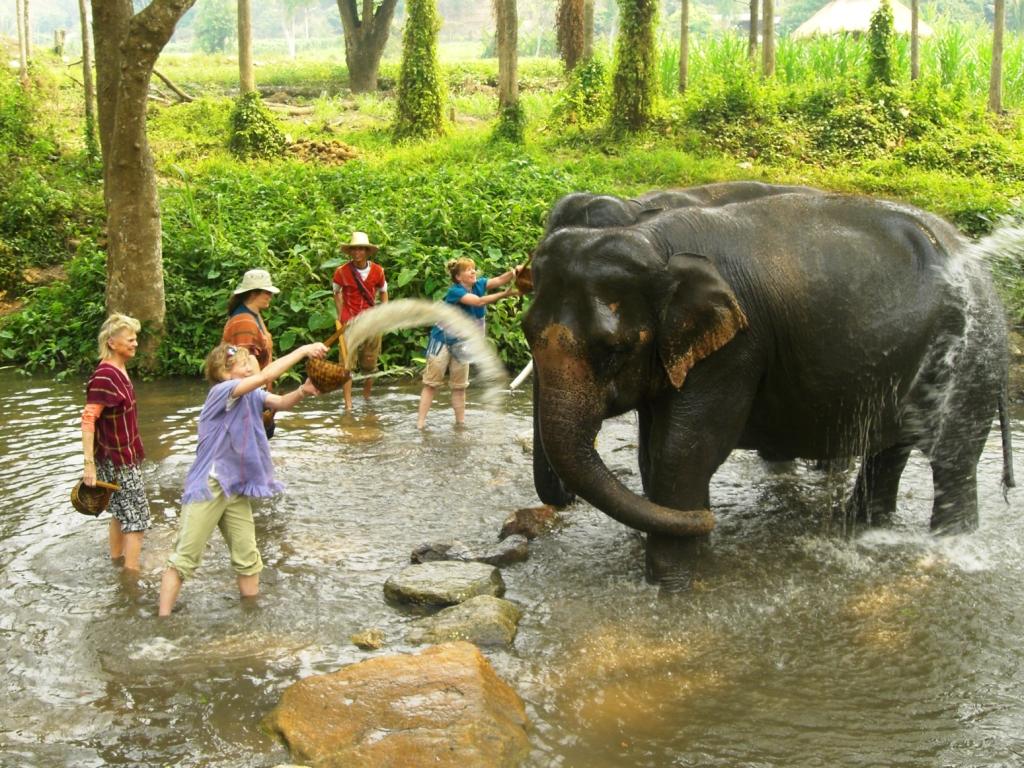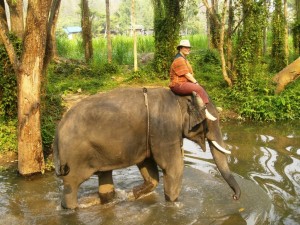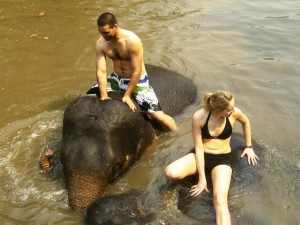DoDo is my responsibility for the day. A big responsibility, four tons of it. He stands seven feet tall, and measures ten feet long.
“He is a champion elephant, this one,” says Teerapat Trungpakan (Pat, for short), owner of Patara elephant farm, located just over an hour’s drive from Chiang Mai in northern Thailand. “If it was a beauty contest, this elephant would win.”
I glance at DoDo, who has dirt caked into his hide. He swings his trunk and stares back. Being a champion elephant, Pat says, involves conformation and proportions and size and tusk quality and coloring, but to me DoDo seems mostly just very big.
In Your Bucket Because…
- Travel is all about new experiences, and you’ve never done anything like this before.
- It’s a great balance of learning, working, riding, and just plain fun.
- The focus here is not “tourist attraction” but elephant rescue, care, and conservation.
- Good for adventure travelers and animal lovers. Some less fit and flexible participants didn’t enjoy the unusual and teetery ride.
- Great for kids.
Patara is one of more than 20 elephant tourist attractions in northern Thailand, an area popular with adventure travelers. Unlike most other elephant attractions, Patara is more than the typical pachyderm “pony ride,” most of which are rated as abusive by animal rights advocates. Instead, Patara’s day-long program, which costs about $180 US, teaches tourists every aspect of an elephant’s daily care. Visitors learn to assess the health of, bathe, groom, and ride elephants under the supervision of the elephant’s mahout, or trainer. However, I have the suspicion that the elephants obey the real mahouts far more than the tourists.
The ABCs of Elephant Care
My relationship with DoDo began with some basic elephant etiquette: I was supposed to call out DoDo’s name and the command “Cha.” If DoDo was happy and willing to interact, he would swing his tail and flap his ears; if he wasn’t, he might have held his ears straight out to the side. Approaching DoDo, I felt a little like the students approaching the fictional hippogriff in a Harry Potter novel. But DoDo was an old hand and a generally agreeable fellow: He responded by raising his trunk, meaning that he was willing to accept my offering of an enormous basket of bananas and sugarcane.
The next job for me as “elephant owner for a day” was to with assess DoDo’s health. I looked at him, wondering how I was supposed to know. Pat came to the rescue, telling me to look for signs that he’d slept well, that he was eating well, and that he was drinking and sweating enough.
So first: Was DoDo an insomniac? Apparently not, as dust all over his skin was a tell-tale sign that he’d spent the night lying down. But then we moved on to DoDo’s dietaray habits, and here things got a bit more personal. I’d have to check the quality and quantity of manure to know if he was eating well; for those interested, good quality manure resembles chopped up hay, smells like hay or grass, and is wet. As for whether he had a drinking problem or not, I needed to see if he was sweating normally. The dry, cracked dust-covered skin didn’t look so good on this account, but Pat assured me that all was well: There were minute drops of sweat marks between DoDo’s toes, which is the only place where an elephant sweats.
Grooming an elephant is kind of like grooming a whole team of very large horses who have all spent the night rolling around in a pig pen. Pat handed me a brush made of sticks and leaves, and, currying in the direction of the grain of the skin, I raised up a thick billowing cloud of dust. To reach DoDo’s head and back, I commanded “non long!” which tells the elephant to sit down. Once the dry grooming was complete, I tugged on DoDo’s ear, commanded “Ma! Ma!” and led him (or perhaps he led me; after all, he knew the drill) down to the river. Using buckets of water and a stiff brush, and getting thoroughly drenched in the process, I then bathed him from trunk to tusk to tail.
Learning to Ride an Elephant
Finally, it was time to learn to ride the elephant. The first challenge is actually getting on an animal that, in DoDo’s case, stands 7 feet tall. Depending on how an elephant has been trained, not to mention the strength and coordination of the rider, there are three possible mounting techniques. The easiest is to ask him to sit down; then climb on, using the elephant’s leg as a sort of stepping stool. Another method is to command the elephant to lift his front leg, and climb on by stepping on his raised foot, putting another foot on his knee, and climbing onto his back (it’s easier than it looks). The third way is to climb on via the trunk, which the elephant will obligingly lift so that the rider can scramble up the trunk and onto his head.
The basic sitting position is on the elephant’s head. Following Pat’s instructions, I placed my feet just behind the elephant’s ears, and used my feet to give signals — stop, go, right, and left — much like in horseback riding. If there are two riders, the second rider sits on the elephant’s back, just behind a rope that runs around the elephant’s midsection (which is placed there for a novice rider to hang on to for a sense of security). More advanced riders can both sit on the elephant’s head, with the rider in front hanging her legs over the elephant’s forehead, and the rider in back giving signals by pressing his feet against the elephant’s ears.
Elephant Trekking
Our lessons were now over and it was time to ride. It is an uncomfortable feeling, not in the least like sitting on a horse. You are much higher up, and the elephant sort of rolls underneath you and it takes a while to adjust your balance when the trail goes steeply up or down. The ride to a nearby waterfall took a steep jungle trail that looked, quite frankly, impossible for so big an animal to negotiate. (An easier alternate route was available via the road). But with three feet always on the ground, elephants are surefooted and careful, and they can climb up hillsides that look frankly impossible for a human to navigate, let alone a four-ton animal.
At the waterfall, the elephants were set free to bathe and play in the river, while we humans enjoyed a locally prepared lunch served on banana leaves (the elephants obligingly cleaned up for us by eating the placemats, tablecloth, and food wrappers at the end of the meal). Every once in a while, an elephant would turn its water-filled trunk in our direction, and I swear, it would laugh as it sprayed us soaking wet. After lunch, we got to swim with the elephants before riding back to the farm. The day ended with a quiet easy ride to a local temple.

I certainly can’t call myself an elephant expert. DoDo seemed to be amused at my orders, and I had the distinct feeling that while he politely pretended to listen to me, he only obeyed the real boss: the mahout who walked alongside of us. But at the end of my day at Patara Elephant Farm, I certainly felt that I’d gotten a glimmer of understanding of what it takes to handle, communicate with, and enjoy these massive and intelligent animals — a much more worthwhile and educational experience than simply riding for an hour or two.
Practicalities
- Bring a change of clothes. Patara does give you clothes to wear over your own (a sort of “uniform” that tells the elephants you’re one of the good guys). Nonetheless, expect to get wet and dirty.
- Bring a bathing suit to swim in the waterfall with the elephants.
- You’ll appreciate having bug repellent.
- A few dollar’s tip to your guide at the end of the day is appreciated.
This article has been updated from a story published in 2012.






One thought on “Mahout for a Day: Learning to Care for and Ride Elephants in Thailand”
Comments are closed.